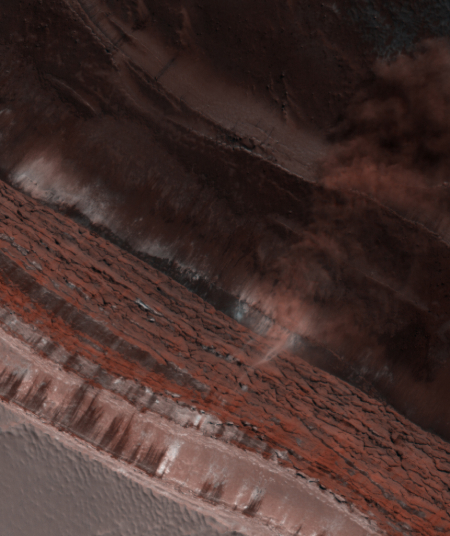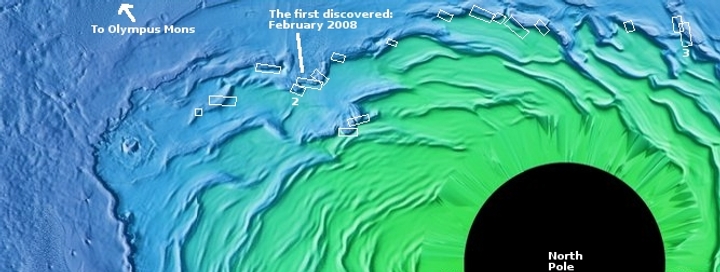Avalanche season at the Martian north pole

Click for full resolution image.
As the Martian spring started to unfold in April 2019, the focus of many Martian planetary scientists immediately shifted to the northern polar icecap, where they fully expected, based on previous experience, some spectacular events to occur.
I have already reported on this year’s initial observations of the sublimation of the carbon dioxide frost layer. That frost layer, generally less than six feet thick, falls as dry ice snow with the coming of winter, then sublimates away each spring. Since the arrival of Mars Reconnaissance Orbiter (MRO) in 2006 and its discovery of this process by its high resolution camera, these scientists have been monitoring the disappearance of that frost layer from Martian year to Martian year.
That sublimation process also brings with it other spectacular changes, including the coming of frequent avalanches along the high cliff scarps, ranging in heights from 1,500 to 3,000 feet, that comprise the edge of that north pole icecap. The image above, reduced to post here, shows one of the many avalanches found this spring and photographed as they were actually happening. It looks down at the cliff that runs from the left to the lower right of the image, with its top being the flat plateau in the lower left. From the caption, written by Dr. Candice Hansen of the Planetary Science Institute in Tucson, Arizona,
Every spring the sun shines on the side of the stack of layers at the North Pole of Mars known as the north polar layered deposits. The warmth destabilizes the ice and blocks break loose.
When they reach the bottom of the more than 500 meter tall cliff face [about 1,600 feet], the blocks kick up a cloud of dust. (In the cutout, the top layer of the north polar cap is to the lower left.) The layers beneath are different colors and textures depending on the amount of dust mixed with ice.
The linear many-layered look of that cliff face is due to the many layers believed to exist within the permanent water icecap of Mars. To give some perspective, this cliff is several hundred feet taller than the World Trade Center after completion. Those falling blocks are dropping farther than the bodies that horribly fell from the Trade Center the day it was hit by airplanes flown by Islamic terrorists on September 11, 2001.
The map below shows most of the eastern half of that icecap, with the white boxes showing the various places MRO has spotted such avalanches.

Though it is possible this map is incomplete, I think I have captured most of the monitoring sites in this part of the icecap. I also found in my survey of the MRO image archive that the bulk of the monitoring is in this area. There are other monitoring sites elsewhere on the icecap, but not as many.
The site labeled #2 is the location of the avalanche in the first image above. If you take a look at the full image, you can actually spot at least one more avalanche in the color strip that is not mentioned in the caption, with several others possible along the cliff in the image’s black and white section.
The site labeled #3 is the location of a previous avalanche image that I posted on October 26, 2011.
Since the first on-going avalanche was photographed in 2008, planetary scientists have established a regular monitoring program for these locations, returning each Martian spring every few weeks to see if they can spot new avalanches.
Initially, they needed to find where the avalanches were occurring. “We looked at the steepest places first, then the shallower places,” explained Shane Byrne of the Lunar and Planetary Lab University of Arizona. “After we completed that process we found that the avalanches only really happen on the steepest cliffs.”
This fact explains why most of the best avalanche sites are found on the icecap’s eastern side, as that is where the steepest cliffs are located. The western icecap simply does not have such steep scarps. “Why steep cliffs only occur in that area and not elsewhere, that’s a mystery,” noted Byrne. “We don’t know the answer to that.”
The links below are a sampling of the seasonal monitoring of this original discovery site with the coming of each new spring, some of which clearly show additional avalanches, some noted with a caption and close-up, others with no additional public commentary.
- February 19, 2008
- December 19, 2009
- January 7, 2010
- January 12, 2010
- January 27, 2010
- August 10, 2013
- August 26, 2015
- September 20, 2017
- July 11, 2019
According to early conclusions of Patrick Russell of the University of Bern, Switzerland,
Based on this year’s observations [in 2010], these events happen mostly in the middle of spring, roughly equivalent to April to early May on Earth. And, they are indeed more widespread than just this one scarp. All together, it seems this is a regular spring process at Mars’ North Pole that may be expected every year—avalanche season!
Based on subsequent monitoring work, the scientists have found the rate of avalanches in the spring can be quite astonishing. “It is incredible. I think this is the most incredible thing about the whole process.” said Byrne. “If you fly over a mountain range on the Earth and take a picture, the chances catching an avalanche in progress are almost zero. But on Mars half of the images we take in the right season contain an avalanche. There’s one image that has four avalanches going off simultaneously at different parts of the scarp. There must be hundreds to thousands of these events each day.”
There are presently two theories for explaining what causes these avalanches, both related to the coming of spring and the sudden warming as sunlight hits these cliffs. In the first case the heating is thought to cause the abrupt sublimation of the carbon dioxide frost that has settled in the nooks and crannies of the cliff during the winter, which as it is released disturbs the larger ice blocks, causing some to fall. In the second case it is thought that the sudden change in temperature alone acts to loosen the blocks.
Either way, we are right now in the middle of the Martian avalanche season. And since these avalanches appear to be so reliable and frequent, I can someday imagine Martian tours to the cliffs, to watch avalanches occur from a safe distance, just as tourists today take Alaskan cruises to see giant ice blocks calf off glaciers.
One more fascinating tidbit: The cliff in the first image above is only 3 to 6 miles to the north of the same dunes dubbed Buzzell that Hansen is monitoring for changes as summer approaches. Buzzell therefore might actually end up becoming the very tourist spot for watching these avalanches.
On Christmas Eve 1968 three Americans became the first humans to visit another world. What they did to celebrate was unexpected and profound, and will be remembered throughout all human history. Genesis: the Story of Apollo 8, Robert Zimmerman's classic history of humanity's first journey to another world, tells that story, and it is now available as both an ebook and an audiobook, both with a foreword by Valerie Anders and a new introduction by Robert Zimmerman.
The print edition can be purchased at Amazon or from any other book seller. If you want an autographed copy the price is $60 for the hardback and $45 for the paperback, plus $8 shipping for each. Go here for purchasing details. The ebook is available everywhere for $5.99 (before discount) at amazon, or direct from my ebook publisher, ebookit. If you buy it from ebookit you don't support the big tech companies and the author gets a bigger cut much sooner.
The audiobook is also available at all these vendors, and is also free with a 30-day trial membership to Audible.
"Not simply about one mission, [Genesis] is also the history of America's quest for the moon... Zimmerman has done a masterful job of tying disparate events together into a solid account of one of America's greatest human triumphs."--San Antonio Express-News


Scott Manley did a very interesting video on this. Doug Ellison seperated out each channel on the RGB views andd did a short gif on the movement.
Scott Manley vid: https://youtu.be/9S-unfSAWVc
Doug Ellison twitter: https://twitter.com/doug_ellison/status/1169845018497974274?s=20